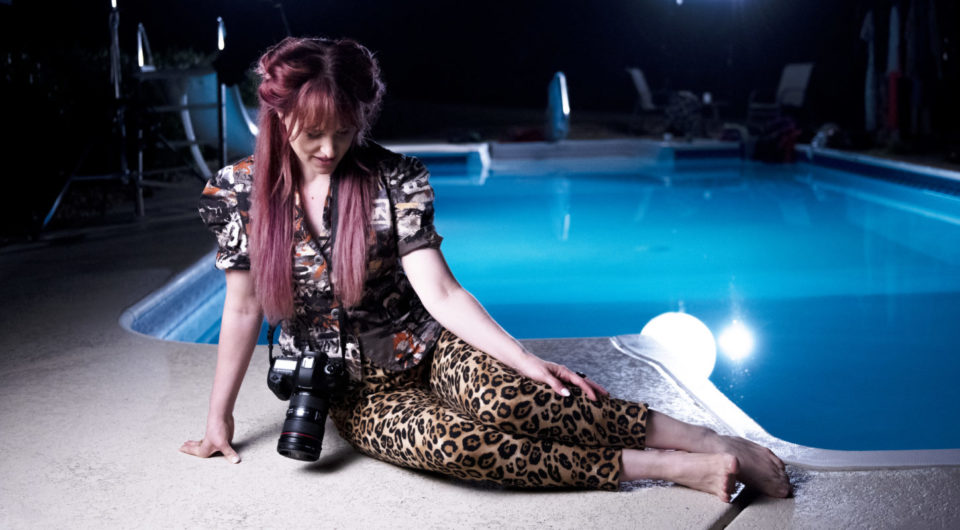ONE OF A KIND “WATER PHOTOGRAPHY” THAT REVIVES CARAVAGGIO AND REMBRANDT



Christy Lee Rogers is a visual artist from Kailua, Hawaii, known for breaking the rules of conventional photography, by utilizing the refraction of light through water to create painting like images under very dark lighting conditions. Her use of Chiaroscuro lighting, a Renaissance-period term describing the use of strong contrasts between light and dark, and which was made popular by artists like Caravaggio and Rembrandt, made her famous in the world. She is also known for using real people as her models to evoke the vulnerability of the human condition is her works. Her obsession with water as a medium for breaking the conventions of contemporary photography. She applies her cunning technique to a barrage of bodies submerged in water during the night, and creates her effects using the refraction of light. For her it represents the beauty and vulnerability of the tragic experience of the human condition.
Rogers’ works have been exhibited globally from Paris, London, Italy, Mexico City to Shanghai, Sao Paulo, South Africa, Los Angeles and more, and are held in private and public collections throughout the world. She has been featured in International Magazines, including Vogue, Harper’s Bazaar Art China, Elle Decoration, Global Times, The Independent, Casa Vogue, Photo Technique, Photo Korea and others. Rogers’ “Reckless Unbound” is currently housed at Longleat House in the UK; the stately home, which is the seat of the Marquesses of Bath and also home to Renaissance gems of the Italian masters, like Titan’s “Rest on the Flight into Egypt.” This year she will be publish also in Poland in Trendy.Art of Living.
She is a double finalist for the Contemporary Talents Award from the Fondation François Schneider in France, and has been commissioned by Apple to create underwater images with the iPhone 11Pro, as well as being featured in one of their behind-the-scenes process films. Rogers’ art has been featured on several album covers, including “Orchesography” for the 80’s band Wang Chung, and her images were selected for the 2013–2014 performance season of the Angers-Nantes Opera in France. In 2019 she won Open Photographer of the Year at the Sony World Photography Awards. To JL Interviews she confessed that her inspiration was Fellini’s cinema and this year she prepares a big project involving photographs and films, that will be shooting in Hawaii.
Have you always been interested in Baroque art, especially in Caravaggio? If no, when did it start? If yes, why this period of time, why Caravaggio?
In many ways I feel very connected to Baroque art and Caravaggio. There must be something deep inside of me, that I’m not fully consciously aware of, that pulls at my heart. It was never an intention to re-create any part of this period of art, but I am obsessed with movement, drama, human figures, light and shadow, and the sense of something greater than oneself. This is part of who I am, part of something I must say. My love for creating images that are beyond our reality, and questioned reality, also have a big part in choosing this style of creation. This is where the mysterious search for freedom can be explored.
You are one of the most original artists of our times. How is it possible to do such an amazing masterpiece under the water? How that idea was born in your mind?
Everything is magical under water. Like a whole new undiscovered world. Water is so beautiful and tranquil, which led to my first experimentations with it as an artistic source over 17 years ago. Through that experimentation, I believe I was able to go to new and unknown places, and to let go of all of the rules and expectations. The first artworks that I created were done after a time in my life that I had hit rock bottom and I remember having absolutely no money and a huge black eye from fainting and crashing my head against the wall. After realizing that I would not die, I started to see what really mattered to me. From there I created like mad and with a new heart, a heart full of compassion and possibility, with no fear. I know this period in my life helped me to be true to who I was and my art.
How much time does it take to prepare one picture under the water? Could you describe us all the preparation process (poses, lights, clothes, models)?
The year starts with a notebook of ideas that I keep thourghout each and every day of concepts, color palettes, sketches and costumes that will be needed to materialize the main concept. There is alwasy a main driving concept that I’m looking to communicate with each collection, and from there I put together the models and all of the right elements that I feel will help represent those ideas. I also write out shot lists before each shoot night. Then as I’m live with the models, the process takes us away on an adventure. This experimention allows us break our chains and be free to go in new directions. Before the shoot, I will go over the process with each model, explaining how their body will be positioned in the water and in relation to the lights and each other. We practice a lot and I want them to eventually let go under the water and overcome that vulnerability that we all feel without being able to breathe. More than poses, I really want them to imagine scenes, to be free and feel the depth of the feelings that represent the main concept. Because the lighting can change from scene to scene, they also have to be in sync with the lights. Costumes are collected throughout the year and also experimented with. Color, textures and their movement can change the whole landscape. I always choose artists, musicians, dancers, and people for their heart, enthusiasm and for the way they inspire me. Every-day people that I meet inspire me the most, because they’re real about their experience in the water. It’s not easy to be down there but that’s also what I want to capture, is that struggle and vulnerability. This is the beauty, to work through this.
‘Muses’ Christy Lee Rogers Behind the Scenes Hawaii Underwater Shoot
Why the water is for you such a good background for photos? Is it because you just love it or is there some primordial sense behind it?
I’m in love with water in every way. It’s life and peace to me. And with water, it’s as though you have a blank canvas to photograph on. Nothing is as it seems and as the light moves over many layers of water, bodies and fabric, as there is bending and magic happening here. For me it was like finding the fountain of youth, except this is the fountain of creativity. Yes, it must also be primordial, in that we are all made up of mostly water, the panet is mostly water, we are born in water, needing water to live and purify us. Water is alive and has memory and something I respect dearly.
You have exhibited all over the world, but not in Poland or Rome. When are you planning to visit this two places?
I would love to do that next. And I adore Rome, and have been there many times, and completely love Italians. My hope is to visit Poland soon, as I have never been there. And have both Polish and Italian ancestry.
What will be your next exhibition about (and where)?
There are many unconfirmed shows at the moment, with dates pending (one in Italy), a show at the Minnesota Marine Art Museum in 2020, along with many group shows through Europe. And I’m excited to release some big commissions and projects that will launch early 2020, which unfortunately I can’t talk about yet. And this year has been a record of shooting for me, with a big project involving photographs and films, that I will continue shooting in Hawaii.
You said: “My purpose behind the work is to question and find understanding in the craziness, tragedy, vulnerability, beauty and power of mankind.” Beautiful phrase. Is this a sense of art for you?
Yes, art, but also it is a sense of life for me. Art is life and life is art. Each image and shoot is a question I need answered and a way to research and dive into those areas.
What do you think about contemporary humanity? Are you a pessimist or optimist?
Optimist for sure. I believe that if we can see the good in others and ourselves then we can create it. But first we must believe, forgive and work on ourselves. We’re all so beautiful at the core of who we are and it’s my wish that everyone will really see this in themselves. My other wish is that we can find forgiveness for of ourselves and others. And not the kind of forgiveness that has anything to do with blame but a deeper acceptance that we’re all in this together, that we’re stronger if we bind together. Taking responsibily and instead of reacting back against some evil, to just give love. Then the evil has no place to live. The cycle ends. I see so much destruction in life, how we can destroy ourselves for no real reason, and this keeps me up at night. It seems to me that the human mind is corrupt in some way, like a corrupt hard drive. I don’t know if people are actually making the choice to have these thoughts or if it’s on automatic. So maybe art, love and beauty can take us out of the mind and into something way higher than that—us. I have to beleive that that’s possible.
You were born in Hawaii. How much your country influenced you as a person and your art?
Hawaii is at the core of who I am. This tranquil healing land and water that surronded me as I grew up, gave inspiration and strength. Childhood days were mostly spent in the ocean, water falls, canals and rain. We celebrated the rain and ran freely out in, barefoot and blissful. We did also have floods that destroyed part of my house, so I know both the healing and destructive parts of water well.
I think no one thinks about Hawaii as an art island, everybody associates this place with the sea and holidays. What museums or art center would you recommend on the island?
The Honolulu Academy of Arts Museum is fantastic and I love to see what the local artists create in ceramics and pottery. Cedar Street Gallery and Fine Art Associates are amazing as well and two of the first galleries that represented my work.
Picasso said that every child is an artist; the problem is how to remain an artist once he grows up. How was it in your case? Were you a very artistic child? Is it easy to be the artist nowadays?
I was a complete artist as a child, very interested in performing arts, poetry, directing and filmmaking. But as Picasso says, I did lose it for a while after my schooling. It was as if the world was saying—no you will never make it as an artist and my creativity stopped. But luckily I found it again and will never lose it now. Each adult is also an artist, they just have to look inside and find themselves again.
What was your first photography that you or someone defined “art”, do you remember? Do you remember that person?
That’s a great question! Some of the first art photographs that I took were of found objects that I placed together randomly. What I do remember was being a muse for my high school boyfriend obsession with photography, developing prints in the bathroom and how he bought me my first 35 mm used camera.
This year, 2019, you won Open Photographer of the Year at the Sony World Photography Awards. What this award means to you?
This was a huge honor and I very grateful to their team, who were tremendous and so much fun to work with. The artwork was able to travel all over the world, and all over the internet. It was a beautiful way to reach out to so many people with an image called “Harmony”, which was a message that I’ve always wanted to share so broadly.
Which photographers were important for your career and why?
The most important inspirations in my life were actually with filmmakers like Fellini. I fell in love with his breathtaking and genius films as a teenager. Every visual captivated me in a hundred different ways. I couldn’t breathe when I watched them. Baz Luhrmann is another favorite inspiration, for his brilliant visuals, costumes and editing.
Written by Joanna Longawa







